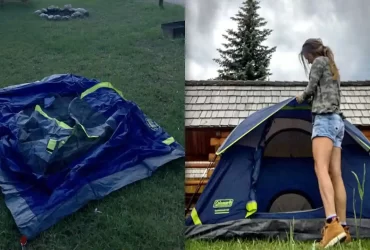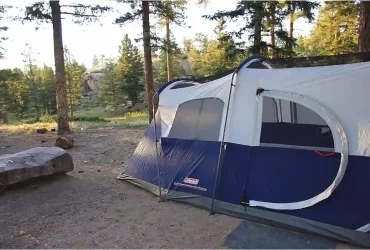Keeping camp chair clean is an essential part of maintaining its lifespan. Whether you’re a frequent camper or just someone who enjoys outdoor activities, it’s important to know how do i clean camp chair properly. Best Camp chairs can easily get stained and dirty due to constant exposure to the elements, food spills, and general wear and tear. An overview of different cleaning processes you can try depending on the material of camp chair.
If you have a fabric camp chair, start by using a soft brush or cloth to remove any loose dirt or debris from the surface. Next, mix some mild detergent with water and use a sponge or cloth to gently scrub the surface of the fabric. Be sure not to use too much water, as it can damage the fabric’s waterproof coating. Rinse thoroughly with clean water and let it air dry completely before storing.
For plastic or metal camp chairs, you can use a mixture of warm water and dish soap to wipe down the surfaces with a soft cloth or sponge. For tougher stains, you may need to use an all-purpose cleaner or even vinegar diluted in water. Be sure to rinse off any cleaning solution with clean water and let it dry completely before storing.
If camp chair has mold or mildew on it, mix equal parts white vinegar and water in a spray bottle and spray directly onto the affected area. Let it sit for 10–15 minutes before wiping it away with a damp cloth.
To prevent future stains and dirt buildup, consider using a protective cover for camp chair when not in use. This will also help prolong its lifespan by keeping it out of direct sunlight, which can cause fading over time.
Regular cleaning is key to maintaining camp chair’s hygiene and comfortability during outdoor activities. By following these simple cleaning processes based on specific type of camp chair material, you can ensure that camping experience is always enjoyable without having to worry about dirty or stained chairs.
Necessary Products for Cleaning Camp Chairs
Fabric chairs are a popular choice for camping trips, but they can easily get dirty from exposure to the elements. Fortunately, cleaning them is relatively easy with a few household items and some elbow grease.
Damp Cloth and Mild Detergent
One of the easiest ways to clean fabric camp chairs is by using a damp cloth and mild detergent. Start by wiping down the chair with a damp cloth to remove any loose dirt or debris. Then mix a small amount of dish soap or laundry detergent with warm water in a bucket.
Dip cloth into the solution and wring it out so that it’s not too wet. Wipe down the entire surface of the chair, paying special attention to any stains or areas that are particularly dirty. Rinse cloth frequently in clean water and repeat until you’ve cleaned all parts of the chair.
Commercial Cleaners
If you have tough stains on camping gear that won’t come out with regular detergents, there are commercial cleaners available that can do the job effectively. These cleaners are designed specifically for outdoor fabrics like those used in camping chairs and tents. They work by breaking down stubborn stains and dirt without damaging the fabric itself.
White Vinegar and Bristle Brush
For furniture parts like frames, legs, or armrests, white vinegar mixed with water is an effective cleaning solution. Mix equal parts white vinegar and water in a spray bottle and apply it generously to any dirty parts using a bristle brush or toothbrush to scrub away grime buildup from crevices.
Spray Bottles
Spray bottles are handy tools when applying cleaning solutions to dirty chairs, as they allow you to apply just enough cleaner without oversaturating equipment.
You may also like this:
Cleaning Different Types of Camping Chairs with Various Methods
Soap and water clean camping chairs
Camping chairs are essential for outdoor adventures, but they can accumulate dirt, dust, and stains over time. The most effective way to clean camping chairs is to wash them with soap and water. This method works well for plastic, metal, and wooden camping chairs.
Start by removing any loose debris or dirt from the chair using a soft-bristled brush or cloth. Then mix a few drops of dish soap in a bucket of warm water and use a sponge or cloth to wipe down the chair thoroughly. Rinse the chair with clean water and let it air dry.
Vinegar-water treatment removes tough camping chair stains
Sometimes regular soap and water aren’t enough to remove stubborn stains from camping chair. In such cases, you can use a mixture of vinegar and water instead. Mix equal parts white vinegar and warm water in a spray bottle and shake well. Spray the solution onto the stained area of camping chair until it’s saturated, then let it sit for 10–15 minutes before wiping it off with a damp cloth or sponge. Repeat this process until the stain disappears completely.
Cleaning camping chairs with mild detergent works best
If camping chair has fabric material like canvas or polyester, then washing it with soap may not be enough, as these materials are prone to staining easily. Instead, spot cleaning with mild detergent is recommended for these types of chairs.
Begin by vacuuming any loose debris from the surface of chair using an upholstery attachment if possible; otherwise, use a soft-bristled brush or cloth to gently remove dirt particles. Mix one tablespoon of mild liquid detergent into two cups of warm water, then dip a clean cloth into this solution before wringing out the excess liquid from it. Dab at any visible spots until they disappear completely.
Cleaning and maintaining camping chairs takes time
Cleaning camping chairs regularly is essential to maintaining their quality and longevity. It’s also important to store them properly when not in use, keeping them away from direct sunlight, moisture, and extreme temperatures. You should inspect camping chairs before each use for any signs of wear or tear and replace any damaged parts immediately. By following these simple steps, you can extend the lifespan of camping chairs and enjoy many more outdoor adventures with them.
Removing Stains and Mildew from Camping Chairs with DIY and Commercial Cleaners
Mild detergent or dish soap can be used to remove stains from camping chairs. For grass stains, mild soap and water can do the trick. However, for stubborn stains, a mixture of vinegar and water is an effective cleaner. Hydrogen peroxide is another option for removing tough stains.
To clean a camp chair with stubborn stains, start by mixing equal parts vinegar and water in a spray bottle. Spray the solution onto the stain and let it sit for 10–15 minutes. Then, use a scrub brush or sponge to gently scrub the area until the stain lifts. Rinse with water and let dry.
Mildew can also be an issue with camping chairs that are not properly cleaned after use. To clean mildew off camping chairs, mix one part bleach with three parts water in a spray bottle. Spray the solution onto the affected area and let it sit for 5–10 minutes. Use a scrub brush or sponge to gently scrub away the mildew before rinsing thoroughly with water.
If you need to clean a camping chair from mold, start by brushing off any loose mold spores outside to avoid spreading them indoors. Mix equal parts white vinegar and warm water in a spray bottle and apply generously to the affected area. Let it sit for 10–15 minutes before using a scrub brush or sponge to remove the mold completely.
In order to prevent future issues with staining or mildew on camping chairs, make sure they are properly dried before storing them away after each use. Consider investing in covers specifically designed for outdoor furniture that will help protect it from the elements.
Proper Storage and Maintenance of Camping Chairs to Prolong Their Lifespan
Storing camping chairs properly is essential to prolonging their lifespan. It’s important to keep them in a dry and cool place, like a garage or shed. Exposure to moisture and sunlight can cause the material of the chair to deteriorate, leading to cracks, tears, or discoloration. If you don’t have access to a storage space, consider covering camping chairs with a plastic bag or tarp when not in use.
Using a bucket or plastic bag is an excellent option for storing camping chairs, as it protects them from dust and dirt. You can stack multiple chairs on top of each other if you’re short on space. However, make sure that you don’t put anything heavy on top of them, as this could damage the frame. Make sure that all the parts are securely fastened before storing them away.
Regular maintenance is crucial for keeping camping chairs in good condition. Wiping them down with a damp cloth after each use helps remove any dirt or debris that may have accumulated on the surface. For tough stains like bird droppings or food spills, use a bottle of dip specifically designed for outdoor furniture cleaning.
If you’re planning on using camping chair for other outdoor activities like fishing or picnicking, make sure that you clean it thoroughly before storing it away again. This prevents mold growth and unpleasant odors from developing over time.
You may also like this:
Tips for Maintaining the Mechanism of Camping Chairs
Regularly Check the Locking Mechanism for Any Signs of Wear and Tear
Camping chairs are essential gear for outdoor enthusiasts. They provide comfort and convenience while enjoying nature. However, like any other piece of equipment, camping chairs require proper maintenance to ensure their longevity. One of the key components that needs attention is the locking mechanism. The locking mechanism keeps the chair stable and secure when in use. Over time, it can wear out due to constant folding and unfolding, exposure to harsh weather conditions, or mishandling.
To maintain the locking mechanism’s integrity, it is crucial to inspect it regularly for any signs of wear and tear. Look for loose screws or bolts, cracked plastic parts, or bent metal pieces. If you notice any damage, repair or replace the affected parts immediately before using chair again.
Lubricate the Moving Parts of the Mechanism to Prevent Rust and Corrosion
The moving parts of a camping chair’s locking mechanism are susceptible to rust and corrosion due to exposure to moisture or humidity. To prevent this from happening, it is advisable to lubricate these parts regularly with a silicone-based lubricant. Lubrication will help reduce friction between the moving parts and protect them from rusting.
When lubricating camping chair’s locking mechanism, avoid using oil-based lubricants, as they attract dirt and dust particles that can clog up gear over time.
Avoid Exposing the Mechanism to Extreme Temperatures or Moisture
Extreme temperatures can cause damage to camping chair’s locking mechanism by expanding or contracting its metal components beyond their limits. High humidity levels can also lead to rust formation on metal surfaces.
Therefore, it is essential to always store camping chairs in a dry place away from direct sunlight when not in use. Avoid leaving them outside during extreme weather conditions such as heavy rainstorms or snowfalls.
Store Chairs in a Dry Place When Not in Use
Storing camping chairs in a dry and cool place when not in use is crucial to preventing damage to the mechanism. A damp environment can cause rust formation on metal surfaces, while high temperatures can cause plastic parts to warp or crack.
To ensure camping chairs remain in good condition, store them indoors in a well-ventilated area away from direct sunlight. Make sure they are clean and dry before storing them to prevent mold growth or unpleasant odors.
Seek Professional Help if the Mechanism is Damaged Beyond Repair
If you notice significant damage to camping chair’s locking mechanism that cannot be repaired through DIY methods, seek professional help immediately. Attempting to fix severe damage without the proper knowledge and tools can lead to further harm or even render the gear unusable.
Professional repair services have the expertise and equipment required to diagnose and repair any damages correctly. They can also advise you on how best to maintain camping chairs’ locking mechanisms for long-lasting use.
Cleaning Outdoor Furniture Cushions and Storage Tips
Soft-Bristled Brush for Removing Dirt and Debris
Outdoor furniture cushions are prone to accumulating dirt and debris, especially when they are exposed to the elements. To clean them, start by using a soft-bristled brush to remove any visible dirt or debris from the surface of the cushion. This will help loosen any stubborn stains or grime that may have accumulated on the fabric.
Mild Soap and Warm Water Solution
Once you have removed as much dirt and debris as possible, it’s time to give patio furniture cushions a thorough cleaning. Mix a solution of mild soap and warm water in a bucket or basin, then dip a sponge or cloth into the mixture. Use this to gently scrub the surface of each cushion, paying special attention to any areas that are particularly dirty or stained.
It’s important not to use harsh chemicals or abrasive cleaners on outdoor furniture cushions, as these can damage the fabric and cause it to wear out more quickly. Stick with gentle cleaners like mild soap and warm water for best results.
You may also like this:
Storing Patio Furniture Cushions
When you’re not using outdoor furniture cushions, it’s important to store them properly to prevent excess moisture buildup that can lead to mold and mildew growth. Choose a dry, well-ventilated area, such as a garage or shed, where you can keep cushions safe from rain, humidity, and other environmental factors.
If you don’t have space indoors for storing patio furniture cushions during the off-season months, consider investing in weather-resistant storage bags designed specifically for this purpose. These bags are made from durable materials that can withstand exposure to rain, snow, wind, and other weather conditions while keeping cushions safe from moisture buildup.
Regular Cleaning is Key to Keeping Camp Chairs Looking New
Camp chairs are an essential part of any camping trip. They provide a comfortable place to sit and relax after a long day of hiking or exploring the great outdoors. However, dirty chairs can be unsightly and uncomfortable. Regular cleaning is important to maintain the new look of camp chairs.
Use Clean Water and a Cleaner to Remove Dirt and Stains from the Entire Chair
To clean camp chair, start by brushing off grass and paper debris from the seat and legs to prevent damage. Next, use clean water and a cleaner to remove dirt and stains from the entire chair. Be sure to follow the manufacturer’s instructions for any cleaner you use.
If camp chair has rust on it, you can remove it with sandpaper or steel wool. Once you have removed the rust, touch up any paint that may have been scratched off during the cleaning process.
Brush Off Grass and Paper Debris from the Seat and Legs To Prevent Damage
Cleaning camp chair regularly will help prevent damage caused by dirt buildup over time. It will also help keep chair looking new for longer periods of time.
When cleaning camping chairs, make sure you choose a location that is well-ventilated and has plenty of sunlight. This will help speed up drying times while preventing mold growth.
When and Where to Clean Chairs
It’s important to clean chairs after every use, especially if you’ve been camping in muddy or dusty conditions. This will help prevent dirt buildup over time and keep them looking new for longer periods of time.
To make cleaning easier, consider investing in a chair cover that can be easily removed and washed separately from the chair itself. This will help protect against stains while also making it easier to clean up any spills or messes that may occur during use.
You may also like this:
Summary: Clean Your Camp Chairs Regularly
Keeping camp chairs clean is essential to prolonging their lifespan and maintaining their appearance. Neglecting to clean them regularly can lead to stains, mildew, and even damage to the chair’s material. We’ve provided you with various methods and tips for cleaning different types of camping chairs, removing stains and mildew, using proper storage and maintenance techniques, and maintaining the mechanism of camping chairs.
To start with, it’s important to have the necessary products on hand before beginning the cleaning process. Depending on the type of camping chair you have, you may need a soft-bristled brush or sponge, mild detergent or soap solution, vinegar solution, baking soda paste, or commercial cleaners.
Next up are different methods for cleaning various types of camping chairs, such as fabric-based camping chairs, plastic-based camping chairs, or metal-based camping chairs. Using these methods will help you get rid of dirt or stains that may have accumulated over time.
Stains and mildew can be particularly stubborn when it comes to cleaning camp chairs. We’ve provided DIY solutions using household items like vinegar solution or baking soda paste as well as commercial cleaners available in stores that work wonders in removing tough stains.
Proper storage techniques are also crucial to extending the life of camp chair. Keeping them out of direct sunlight and moisture is key to preventing damage from UV rays and mold growth, respectively. Also, storing them upright instead of stacking one on top of another can prevent any unnecessary pressure that could cause deformation.
Maintaining the mechanism of camp chair is important too. Lubricating hinges with silicone spray lubricant keeps them functioning smoothly, while tightening loose bolts prevents wobbling during use.
Lastly, we’ve discussed how to clean outdoor furniture cushions using similar methods as those used for camp chairs themselves. Proper storage tips for cushions include keeping them indoors during harsh weather conditions like rain or snow.





Leave a Reply
View Comments